|
The Tower
The 15th Century tower is 82 feet tall. There are good views west to Malvern and north to Worcester Cathedral from the top of the tower. Click here to see a panoramic view from the top of the tower.
The Monument to Sir Edmund Wylde
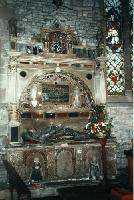 This is dated 1620, as he was made Sheriff of Worcestershire in that year, and died in his first year in office. Although the principal home of the Wylde family was in Shropshire, he was renting the Rectory Manor House in Lane's End at the time. His widow, Dorothy Clark of Houghtom Conquest, Bedfordshire, erected the tomb over his grave. The two kneeling figures are his sons, Edward and Walter. Click on the picture or here for a bigger picture. This is dated 1620, as he was made Sheriff of Worcestershire in that year, and died in his first year in office. Although the principal home of the Wylde family was in Shropshire, he was renting the Rectory Manor House in Lane's End at the time. His widow, Dorothy Clark of Houghtom Conquest, Bedfordshire, erected the tomb over his grave. The two kneeling figures are his sons, Edward and Walter. Click on the picture or here for a bigger picture.
 A choirboy's confiscated chestnut was thrown behind the stone body of Sir Edmund by the sexton. It germinated in 1830, grew over 10 feet tall, and died in the summer of 1895. Click on the picture or here for a bigger picture. A choirboy's confiscated chestnut was thrown behind the stone body of Sir Edmund by the sexton. It germinated in 1830, grew over 10 feet tall, and died in the summer of 1895. Click on the picture or here for a bigger picture.
The Trefoil-headed Piscina
Over the piscina, which is a stone basin for washing communion vessels after the service, is the insignia of Walter de Cantelupe, Bishop of Worcester, 1237-1266.
The Monument to Mrs Elizabeth Eaton
This is in the tower choir vestry, and Mrs Eaton died in 1790.
The Font
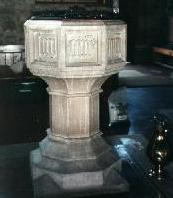
The octagonal stone font was presented to the church by Robert Nuttall in 1852. Click on the picture or here for a bigger picture.
The Pulpit
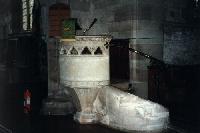
The unusual rounded pulpit of 1863 replaced an earlier wooden three-decker pulpit. Click on the picture or here for a bigger picture.
For a more detailed account of the history of the church and the rectory, click here to go to the entry in the Victoria County History, or here for Rev. Purton's history.
Victoria Cross
Major General Edward William Derrington Bell, winner of the Victoria Cross at the Battle of Alma in the Crimean War in 1854 is buried in Kempsey churchyard. Click here to find out more.
Church Website
The church has a website at
http://www.stmaryskempsey.org.uk/index.html
|
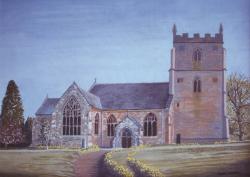
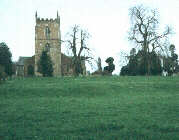





 hits since 9thSeptember 1999.
hits since 9thSeptember 1999.